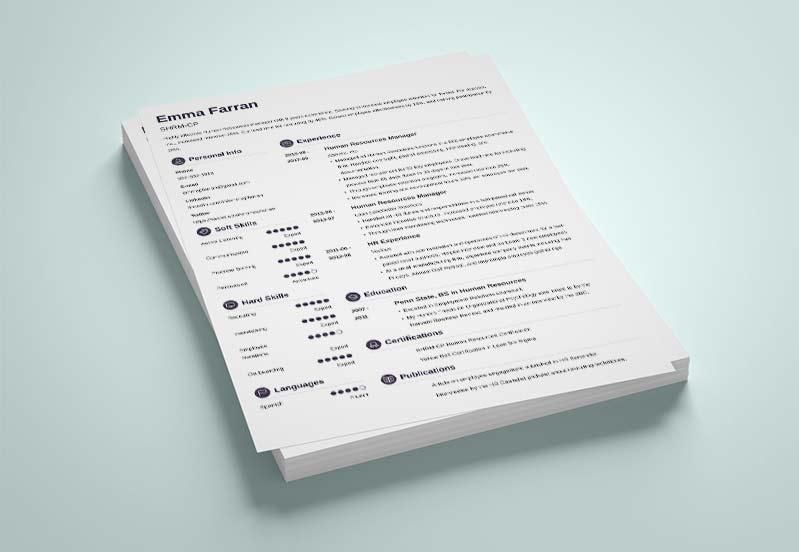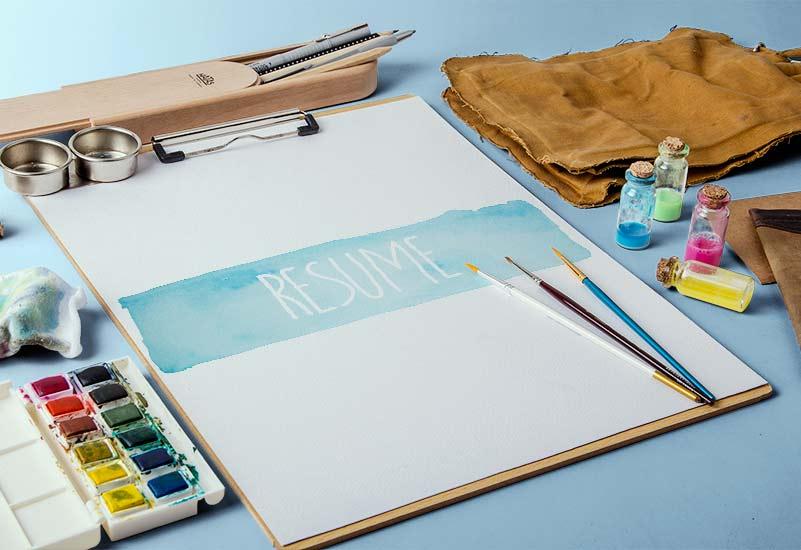
16+ Creative Resume Templates & Examples
You're a creative soul craving a creative resume. Something pretty, but professional. A template that seductively whispers into a recruiters ear: I'm the one.

Don’t have much time, but need a good resume ASAP? Here’s a master list of the best resume tips out there, plus a bonus to make your life easier.
It’s easy to overlook things when you’re worried about finding a job. Maybe you’ve finished writing your resume. Maybe you’re just starting. Either way, you could probably use some good resume tips!
The best tips help you remember the smallest details of resume writing—so here are the best resume writing tips we could find.
Want to save time and have your resume ready in 5 minutes? Try our resume builder. It’s fast and easy to use. Plus, you’ll get ready-made content to add with one click. See 20+ resume templates and create your resume here.
Sample resume made with our builder—See more resume samples here.
For your convenience, we’ve divided the resume tips into categories and added a “star rating of importance” on a scale from one to five.
Importance: ✸ ✸ ✸ ✸ ✸
Think a good resume is a bold resume? Tempted to make your resume stand out with unconventional formatting, visuals, and offbeat fonts? Don’t.
See, most companies use Applicant Tracking Systems these days. This means that the recruiter may never actually lay eyes on your masterpiece because the software won’t let it through!
There are better ways to prove to the recruiter that you’re the most creative applicant. Make sure to stick to proper resume ATS format—more on this in the following sections.
Importance: ✸ ✸ ✸ ✸ ✸
What are the best formats for a resume? Well, that depends. There are three types of resume formats:
Deciding what resume format to choose is an important first step.
Most of the candidates opt for the reverse-chronological format. It’s the most common one, allowing you to play with the layout. It's versatile and works for everything from a resume for the first job to experienced and technical resumes.
Pro Tip: Consider a format that gets your most essential information closest to the top of your resume, where hiring managers will be sure to see it right away. Legibility is what makes a good resume.
Importance: ✸ ✸ ✸
You may think resume fonts are trivial in the larger scheme of things, but the right font will do a lot for your resume.
Stick to fonts that sound like the names of hipster children:
| Right |
|---|
|
| Wrong |
|---|
|
If you choose a font that is hard to read or looks unprofessional, the hiring manager might toss your resume in the trash.
Importance: ✸ ✸ ✸
While choosing a font is important, making sure it’s the right size is paramount.
Keep your resume font size between 10–12 points so that a hiring manager can easily read it without squinting.
Importance: ✸ ✸ ✸
Be consistent with your choices. If you’ve made one of your subheadings bold—make them all bold. Try not to overuse anything. The point is to make essential information easier to find.
Importance: ✸ ✸ ✸ ✸ ✸
Regardless of your resume layout, ensure your resume sections are visible and easy to find. You can do that by giving them simple subheadings:
| Right |
|---|
|
You’ll want to write simple subheadings for all sections, from your resume profile to the list of skills. That way, the Applicant Tracking System (ATS) can find them.
| Wrong |
|---|
|
Pro Tip: Deciding what key skills to put on your resume is one of the biggest tasks for new resume writers. Make sure that they are easy to find and easy to skim as well.
Importance: ✸ ✸ ✸
Resume margins are essential. That’s because resumes with text-crammed edges look messy and unprofessional.
Do you know where messy resumes go? Definitely not onto the hiring manager’s desk.
If you need a little more space, it’s okay to drop your bottom and top margins to 0.5” and your side margins to 0.75”—but not more.
Importance: ✸ ✸ ✸
A hiring manager will first skim your resume for relevant keywords from the job description. Aligning your text to the left makes this easier for them to do that.
Importance: ✸ ✸ ✸ ✸
All best-looking resumes need to be clean and easy to skim. Balancing your text and white space is the same thing as adding margins. It makes your resume aesthetically pleasing and easy to read. Don't sacrifice white space to fit everything onto one page.
Importance: ✸ ✸ ✸ ✸
You've heard it before: a resume has a perfect length. And that's one page. However, most employers expect experienced candidates to submit resumes at least two pages long.
Importance: ✸ ✸ ✸ ✸
Resume templates can save you a lot of time and effort. Imagine not having to fool around with margins in Word. Pick a modern resume template out, and you’re ready to go.
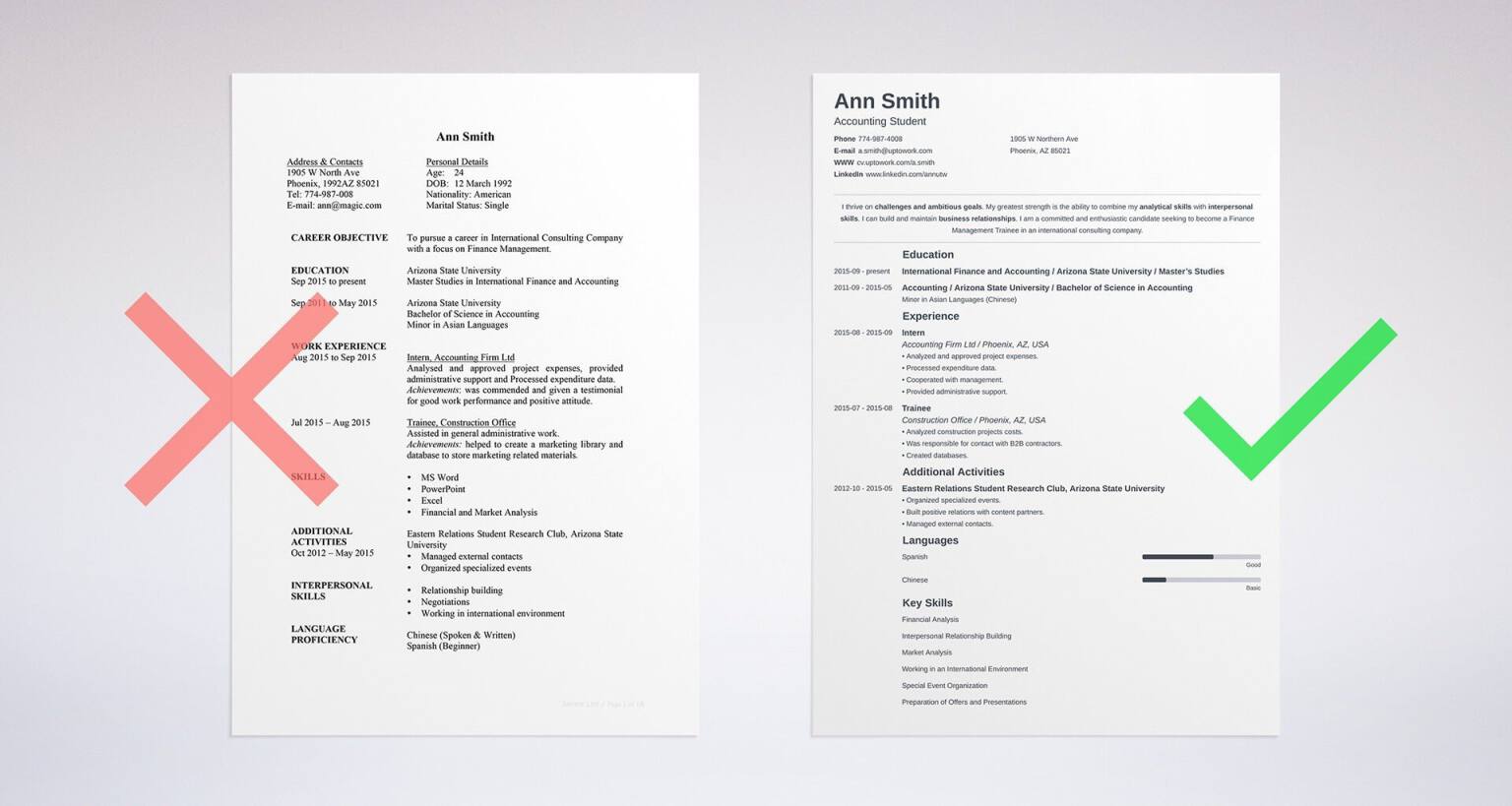
We have a great list of the best resume templates of 2023 for any profession, do see it.
Importance: ✸ ✸ ✸ ✸ ✸ ✸
Out of all the resume-building tips listed, this may seem too obvious.
But it’s worth mentioning because using an unprofessional email address will get you rejected 76% of the time.
So, if you haven’t already done so, ditch that email address you’ve used since high school. Choose a professional email provider like Gmail or Outlook to create a professional alternative. Use your name.
| Right |
|---|
| Wrong |
|---|
| [email protected] |
Importance: ✸ ✸ ✸ ✸ ✸
After you change your email address, double-check that the rest of the contact information on your resume is accurate. You don’t want to miss an interview because you put the wrong phone number on your resume.
Also, exclude information like your birthdate or marital status. You don’t have to respond to questions about religion, race, or gender on an application. US employers can’t consider these aspects when assessing you.
Consider omitting your current address on your resume if you’re applying for a job out of state or country. That way, a hiring manager won’t think you’re confused about the location of the job.
Importance: ✸ ✸
If you have a professional website or blog, include the URL in your contact section.
Add any relevant social media handles as well. Most professionals will include Twitter handle and LinkedIn URL on their resumes. Creative professionals could also consider adding relevant links to Instagram, YouTube, or Pinterest profiles.
Take an extra couple of minutes to make sure your URLs are live and hyperlink them in the text, so they are accessible.
Importance: ✸ ✸ ✸
You can always attach your resume to a generic email and send it to a generic inbox. Or, you can get your resume attached to a personalized email and send it to your hiring manager.
Some hiring managers may not appreciate receiving unsolicited resumes. At the same time, if you know how to email a resume to an employer properly, you know that you aren’t sending it unannounced.
Solution? Establish contact via a referral or LinkedIn before sending your resume.
Want to get your foot in the door, but there are no open positions? Try this guide: How to Send a Cold-Call Cover Letter
Importance: ✸ ✸ ✸ ✸ ✸
Another very important tip for your resume. Think of the top third of your resume as “the penthouse.” You want your best skills, experience, and achievements to appear here.
Why? Because when a recruiter scans your resume, they will focus on the top third of the document.

If they don’t find what they’re looking for in a few seconds of scanning, they will reject your resume as irrelevant. Read more on how to start writing a resume.
Importance: ✸ ✸ ✸ ✸ ✸
So, how do you get your best information in the top third of your resume? Include a resume summary or a resume objective.
It’s three sentences about who you are, where you’re going, and why you’ll bring value to the company. When considering how to write a resume summary or how to write a resume objective, keep in mind that the old-school way is dead.
| Wrong |
|---|
Dedicated Sales Manager seeking fulfilling work in the children's retail sector. |
| Right |
|---|
Dedicated Sales Manager with 5+ years of experience in the retail industry. Wishing to decrease returns for PeaPod Babywear by 15%. |
Always write about what they want, not about what you want.
Importance: ✸ ✸ ✸
You don’t need to list every job you’ve ever had in your resume work experience section. Make sure you go back on your resume no more than 10 or 15 years.
Importance:✸ ✸ ✸ ✸
Yes, it makes sense not to go back in time too much as you list your work experience, but it also makes sense to keep things within context. Had a bunch of short-term jobs in college? Worked somewhere for a month and decided to seek out better options? You might as well keep it off your professional history.
After all, the best resume to get you hired is a resume with relevant experience.
Importance: ✸ ✸ ✸ ✸ ✸
Reading the job description may sound like one of the most obvious resume-building tips. Of course, you’ve read the job description. Right?
Well, most people only spend an average of 76 seconds reading a job description. And that’s why hiring managers find that 50% of applicants are unqualified for the job.
Take the job ad on a date. Buy it Tiffany’s. That job description is your best friend for improving your resume.
And this is how you can use it to do just that:
Seeing a job title that sounds right and sending your resume immediately is the wrong thing to do.
Reading a job description is as close as reading the recruiter’s mind.
Pro Tip: If you want to save time and find out how to write a resume for your profession, take a look at our resume examples.
Importance: ✸ ✸
A cloud generator is a quick way to check that you’ve tailored your resume to meet the hiring manager's needs.
Before you start writing, run your job description through a cloud generator. Which words are the most prominent? Use them while writing your resume.
When you finish writing, send your resume through the cloud generator. Do the exact words appear?
Importance: ✸ ✸ ✸ ✸ ✸
This is crucial: add impressive accomplishments to your resume, not just your job duties.
Illustrating a skill or responsibility with a measurable achievement puts you five steps ahead of candidates with the same skill set. That’s because you’re showing what it looks like when you put your skills to work.
When adding achievements to your resume, use the X, Y, Z approach: “In situation X, I did Y, which resulted in Z.”
| Right |
|---|
To generate user engagement, I performed multiple A/B tests, resulting in a 20% decrease in bounce rates and a 15% increase in sales conversions. |
| Wrong |
|---|
I handled A/B tests. |
Importance: ✸ ✸ ✸ ✸ ✸
Adding numbers and details to emphasize skills is by far one of the best resume tips you can follow. Anytime you can illustrate an achievement or skill with numbers or details—do it.
Numbers draw the eye of the recruiter, and details give them a tangible sense of what it looks like when you use a skill. Maybe you increased sales, efficiency, or user engagement. Perhaps you slashed costs. Whatever it's that you’ve achieved, try to make it quantifiable.
| Right: |
|---|
Increased sales by 12% over 5 months. |
| Wrong: |
|---|
Responsible for sales. |
Importance: ✸ ✸ ✸
Take a quick glance at your resume. How many times have you used the phrase “responsible for?”
A million? It’s not uncommon. The good news is that it only takes five minutes to replace that sad phrase with action-packed verbs.
Using resume action verbs and avoiding resume buzzwords is one of the best resume tips out there. Remember, not all verbs are action verbs. Try to avoid weak verbs like “managed” or “communicated.”
Here are some alternatives:
Wrong: Managed
Right: Orchestrated
Wrong: Communicated
Right: Persuaded
Importance: ✸ ✸ ✸
The essence of this piece of advice greatly varies from industry to industry, but if you have a creative profession, it does make a lot of sense.
Don’t try to squeeze everything into your resume—an image in your portfolio would be worth a thousand words.
Use your resume to focus on your education and professional training, art residences or conferences you’ve attended, awards, etc.
Importance: ✸ ✸ ✸ ✸
Make sure you’ve mentioned any promotions on your resume you’ve received along the way.
You don’t have to list the company's name more than once in the case of internal promotions. Just list your various titles with their accompanying responsibilities:
| RIGHT |
|---|
ABC Company, Inc. Marketing Manager
Marketing Assistant
|
Importance: ✸ ✸ ✸
Putting a bunch of flashy job titles on your resume isn’t the most impressive thing you can do, believe it or not.
What is truly outstanding is telling the story of your career progression.
See, you can be a social media manager for your cousin’s pizza place without prior experience. But when you can show that you progressed to that position through hard work, that’s impressive. The trick is trying to make each past role reinforce your place in the next one:
| RIGHT |
|---|
Marketing Manager
Marketing Specialist
Marketing Intern
|
Importance: ✸ ✸ ✸
Address significant gaps in your career history by writing brief explanations next to the periods where the gaps occur.
Gaps can happen for all sorts of reasons. A brief explanation will reassure recruiters that it was unintentional or beneficial for you, such as a layoff, a break to have a child, or going back to school.
Importance: ✸ ✸ ✸ ✸ ✸
Tailoring your resume is definitely top of the list when it comes to resume tips.
Identify the required skills in the job offer, then add these skills throughout your resume (Skills section + mention them when you describe work experience). It sounds like a lot of work, but these keywords are what you should put on your resume above all else—that’s what hiring managers will be looking for.
Importance: ✸ ✸ ✸ ✸
Time is precious, and so is resume space.
Imagine you’re paying for every line, sort of like if you were buying ad space in a fancy magazine. Every word should serve a purpose.
Don’t waste space with generic duty descriptions—the recruiter knows what the profession involves. Don’t create a random Skills section just for the sake of it being there (ah, the responsible, detail-oriented, positive team player). If you’re claiming you’re great at “leadership,” other sections of your resume should support it, and the skill should be relevant for the job.
Importance: ✸ ✸ ✸
The person interviewing you may not be familiar with the technical jargon that goes with your territory. Especially if you're in a jargon-heavy industry such as engineering, law, or medicine, try to use layman’s terms or simplified equivalents wherever possible.
| Wrong: |
|---|
Dramatically cloudify viral innovation. |
| Right: |
|---|
Create digital backups for popular campaigns. |
Importance: ✸ ✸ ✸
Is your resume a bit longer than the ideal length for resumes (one to two pages)?
Then an easy way to cut fluff is to start by deleting bullet points in your experience section. Limit yourself to around six resume bullet points.
List responsibilities, demonstrating the skills and experience you’ll need for your new job. Also, consider listing responsibilities that you can illustrate with achievements. And don’t list every responsibility you had at previous jobs.
Importance: ✸ ✸ ✸ ✸
If you’re just a learner of the complex art of job hunting, you may be terrified, wondering how to make the best resume possible if you don’t have any experience yet.
Don’t worry! We all had to start somewhere.
You may be surprised, but a strong resume is a resume that meets the company's needs.
So, to write a good resume with no experience:
Importance: ✸✸✸
Once you’ve chosen a format, it’s a good idea to make a quick decision about the layout. How do you build a strong resume that stands out?
After your contact information, start your resume with either a resume summary or a resume objective. More on that later.
But what should come next? Your education or your experience section?
If you’re a professional with tons of experience, your experience should come first.
But let’s say you’re a student and your educational background is your strongest selling point. In that case, consider putting your education section first.
Importance: ✸ ✸ ✸ ✸ ✸
This is one of the best resume tips for students. Adding a relevant coursework description is a good start if you learn how to make a student resume.
Your education section is still your strongest asset. Listing or describing courses can show recruiters that you have skills related to the job.
Coursework descriptions can also benefit professionals who are making a career change resume. It shows that you’ve got relevant knowledge that goes beyond your past work experience.
Importance: ✸ ✸ ✸ ✸ ✸
Are you absolutely sure you don’t have a lot of experience? Because nobody said you had to be paid for what you did for it to land on your resume.
Have some volunteer work experience? Great, mention it. Worked at your parents’ store part-time? Still works! Helped a friend with their Instagram? That can turn into an excellent case to say.
Get creative, think strategically, and never underestimate your background.
When making a resume in our builder, drag & drop bullet points, skills, and auto-fill the boring stuff. Spell check? Check. Start building a professional resume template here for free.
When you’re done, Zety’s resume builder will score your resume and tell you exactly how to make it better.
Importance: ✸ ✸ ✸ ✸
Put your highest, most recent degree first in your education section, and work your way back.
Importance: ✸ ✸ ✸
Going remote opened a whole new world of opportunity, especially in continuing your education and acquiring new skills. Coursera even issues certificates, as do other platforms, so make sure to mention any extra qualifications you’ve received (especially if there is a professional gap).
Importance: ✸ ✸ ✸ ✸
By now, we’ve made it perfectly clear that there’s no need to overload your resume. However, adding extra information to your resume may add value to your application, as they will stand out and grab attention.
Additional sections ideas for your resume:
Think of whatever matters for your industry, but keep it relevant.
Importance: ✸ ✸
If you have space, a list of hobbies and interests can be a great addition to your resume. That’s because companies are beginning to emphasize work culture, which makes finding a candidate with a fitting personality increasingly important.
Just be sure to research your company. Choosing hobbies and interests that match the company’s culture is a good strategy.
| Right |
|---|
Work Culture: Corporation participates in charity marathons Hobbies and Interests: Volunteer Work and Athletics |
| Wrong |
|---|
Beetle fighting, extreme ironing, suing people |
Importance: ✸ ✸ ✸ ✸ ✸
You really can't afford to have typos or grammar errors in your resume. The majority (61%) of recruiters will throw out a resume immediately if they see typos. So good resume spelling is essential.
Microsoft Word or Google Docs detect spelling errors, but tools like Grammarly can catch grammar mistakes and typos.
And while apps are great for catching mistakes, nothing beats having a friend or mentor patiently read through your resume. They can also give you feedback about your tone and how you’re selling yourself.
Importance: ✸ ✸ ✸
Have problems keeping the length of your resume in check?
Importance: ✸
It's no longer necessary to place “references available upon request” at the bottom of your resume, as hiring managers know they can request your list of references. Adding it only takes up valuable space that you could use for something else.
Importance: ✸ ✸
The benefit of saving your resume as a PDF is that the formatting won't change when it’s opened on any device or operating system.
Importance: ✸ ✸ ✸ ✸ ✸
Your resume could end up in an inbox with hundreds of other resumes. And if they’re all named “resume,” then the chance of your resume standing out is slim to none. So a pro piece of resume advice for you: It's important to name your resume files correctly.
| Right |
|---|
PythonDeveloper_Resume_JohnSmith |
| Wrong |
|---|
Resume |
Importance: ✸ ✸ ✸ ✸ ✸
The two best cover letter tips are:
Do cover letters matter? Yes! And yes, they need to match your resume so that you’re telling the hiring manager one cohesive story.
If there was something you feel needs an explanation, write about it in your cover letter—see our great guide on how to write a good cover letter for a job application.
Plus, a great cover letter that matches your resume will give you an advantage over other candidates. You can write it in our cover letter builder here. Here's what it may look like:
See more cover letter templates and start writing.
Importance: ✸ ✸ ✸ ✸ ✸
When you’re just learning how to create a resume, you may forget that hiring managers also search for you online. Be sure to optimize your LinkedIn profile to resonate with your resume.
Make sure that you’ve cleaned up “public” information on your Facebook and Twitter accounts. Change your Facebook privacy settings to “Friends” to keep future posts from becoming public.
And do a quick sweep to ensure nothing else unsavory is lurking on the Internet. Enter your name into Google and see what turns up in the results. You can ask Google to remove sensitive content from the web.
Importance: ✸ ✸ ✸ ✸
Instead of waiting for a phone call, track your email so that you know when a hiring manager opens it.
You can use a free tool like Mixmax to see if a hiring manager has read your resume. That gives you a better idea of when to send follow-up or thank you emails.
Importance: ✸ ✸ ✸
Should we mention again that your resume has to be tailored to each position and always to the point? Probably not.
But you also have to keep it updated every once in a while.
Have you been promoted, received new responsibilities, or gone through new training? Add those things to your resume regularly, and your future self will be forever grateful.
And when the perfect opportunity comes along, you'll be ready to submit that impressive resume right away, beating the competition by miles.
Check out our resume dos and don'ts to avoid more mistakes!
Importance: ✸ ✸ ✸
Do you know what “CPRW” stands for next to a writer’s name?
Yes, Certified Professional Resume Writer is a thing! So if you’re struggling, or the stakes are too high, do ask for help making a resume.
This isn’t a requirement, and such services may come at a considerable price. If you’re not ready to splurge, there’s a great alternative. We’re coming up to the promised bonus!
We’ve just covered the most important and impactful tips for improving your resume… We understand it’s a lot to process!
So here’s something to make your life easier: pick a template from our builder and fill it out in 10 (!) minutes. Thanks to our template wizard, you’ll get sample pre-written entries tailored to your profession (resume wording help that will save you hours!)
See some examples of our templates below, pick the one you fancy, and have a resume ready in no time.

Nanica will be a great choice for candidates applying for jobs in “traditional” fields such as law, finance, or general business. It’s a very simple format. Recruiters will love its classical elegance and easily visible sections. It will also work great for a part-time job resume.
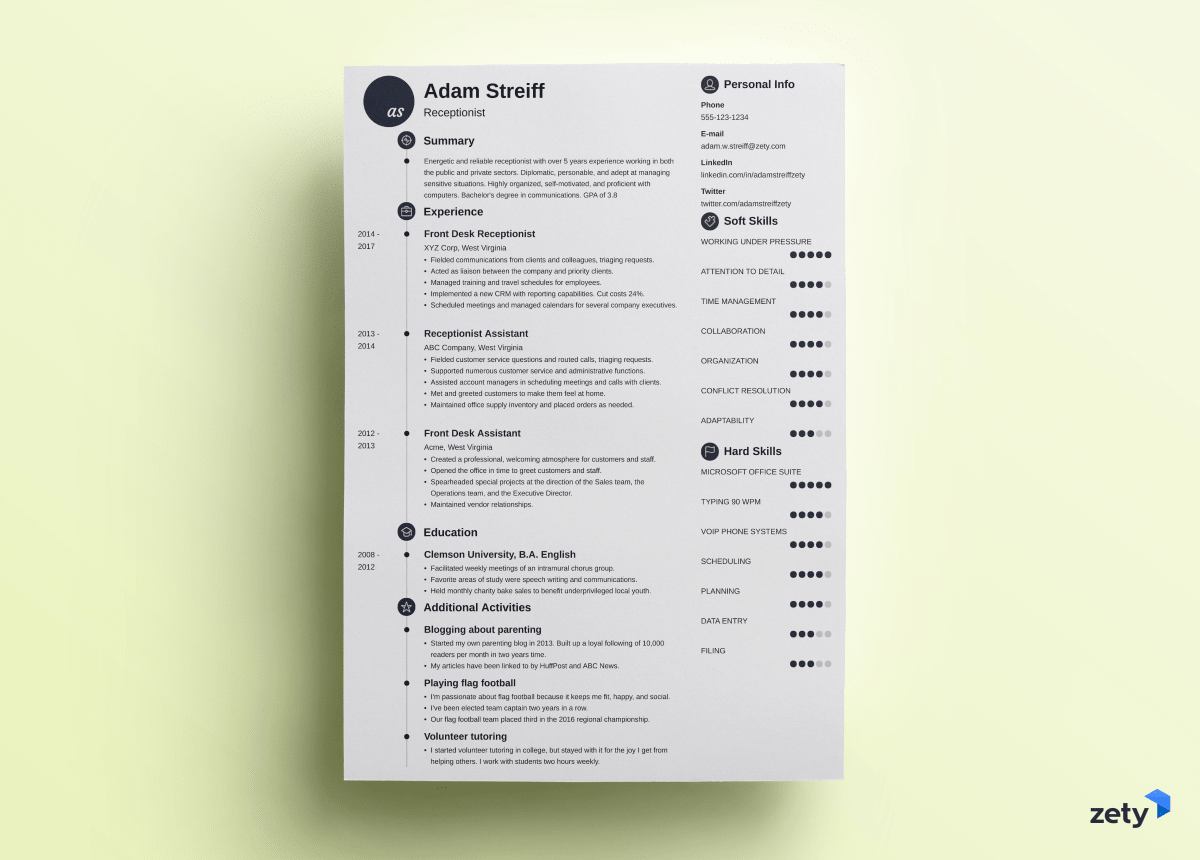
Primo, much like Nanica, is one of our most minimalist resume designs. The cool thing about this one is the two-column layout. It will help you make smarter use of space and fit more information onto a single page. A good resume style for marketing, sales, or customer service candidates. Great for a teen resume, too.
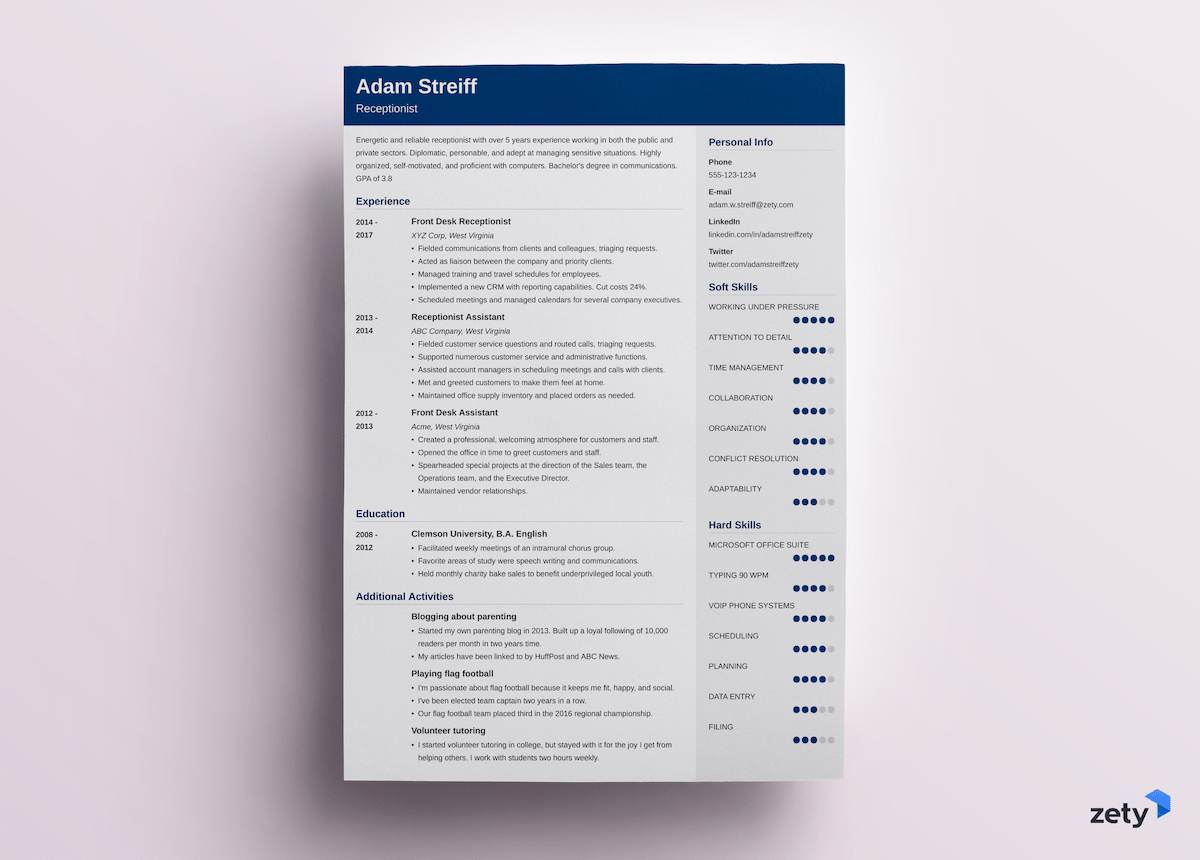
My personal #1 resume tip would be to use the Cubic template. Seriously, I think it’s the prettiest one we’ve ever designed. It has everything: subtle shading, the side column, and a dynamic-yet-elegant design. It’s modern and stylish at the same time. It‘ll work great for job applications in technical fields, such as an IT resume or quality engineer resume.

In this template, section headings, skill levels, and bullets in the work history section are highlighted by little diamond icons—not too fancy but creative enough to grab attention. Diamond is an all-time favorite amongst our users from the business and finance sectors. It conveys professionalism and individuality at the same time. Also, good for a federal resume.
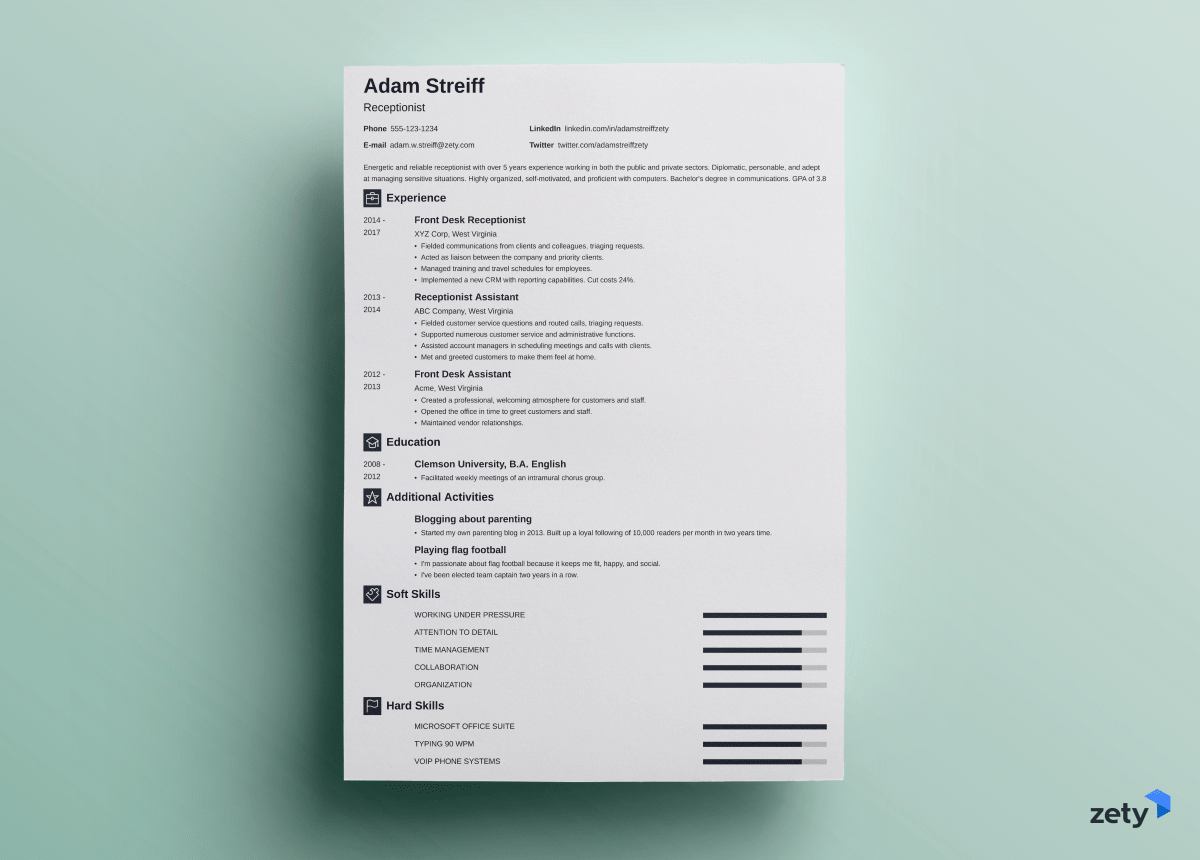
Newcast is a perfect pick for those who like to keep things as simple as possible. It’s a classical resume that tells your career history in reverse-chronological order and uses tons of white space to give recruiters some breathing room. Pick this one if you’re writing an academic CV or eyeing another field considered to be “conservative.”
You can define a resume as a simple list of features. But it should be a list of benefits you'd provide to the employer.
It can be easy to forget small details when figuring out how to write an ideal resume. But if you follow these resume tips and tricks, you can rest assured that you’re on the right track.
Always take the time to check your resume. Can you think of any more quick resume writing tips and suggestions we forgot? What are some little-known resume tips or pointers you can share? Let us know your excellent hints in the comments.
With the Zety resume creator, you won’t need to bring up such questions. The builder ensures the information your recruiter looks for is simply there.
There are things your recruiter doesn’t want to see on your resume, and they are:
To make your resume stand out from the competition, you must:
Function
The goal of your resume is to get you an interview, depending on where you apply. This might be getting a regular job or going into college, winning a scholarship, or recruiting for an internship.
Form
Given your resume needs to serve a purpose, you must know how to make a resume. If you cross your recruiter not applying the basic rules of resume formatting, you can say goodbye to the interview.
e(F)fectiveness
An effective resume fulfills its purpose, follows the right format, and contains only relevant information.
You're a creative soul craving a creative resume. Something pretty, but professional. A template that seductively whispers into a recruiters ear: I'm the one.
Not only do our simple resume templates please the recruiter's eye, but they are also ATS-scannable. Here's a selection of our best basic CV templates you can download now.
Great skills? Amazing layout? Good work history section? What’s the secret behind a *perfect* resume? You’ve come to the right place to find out.
